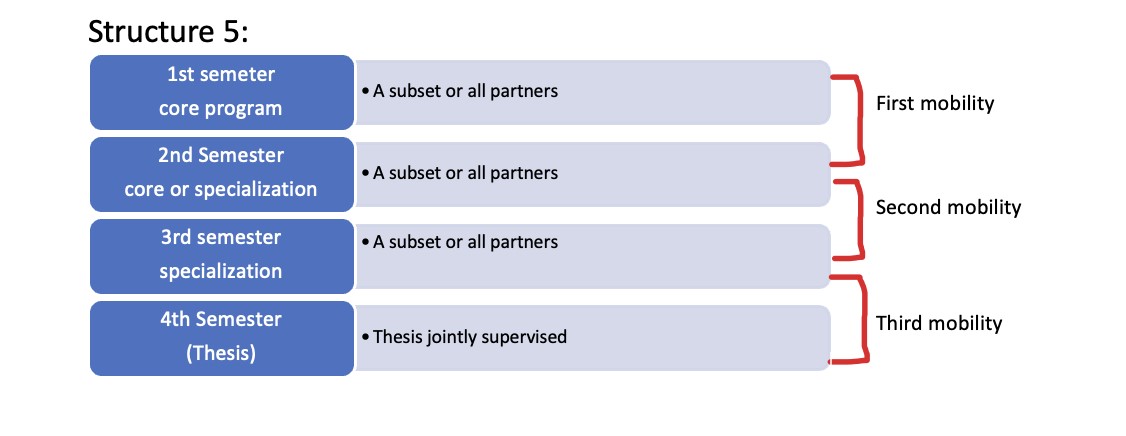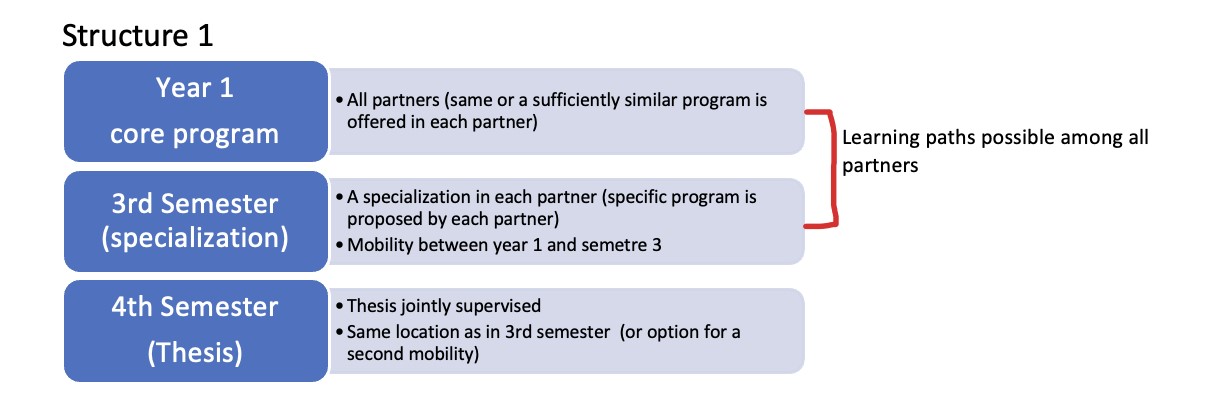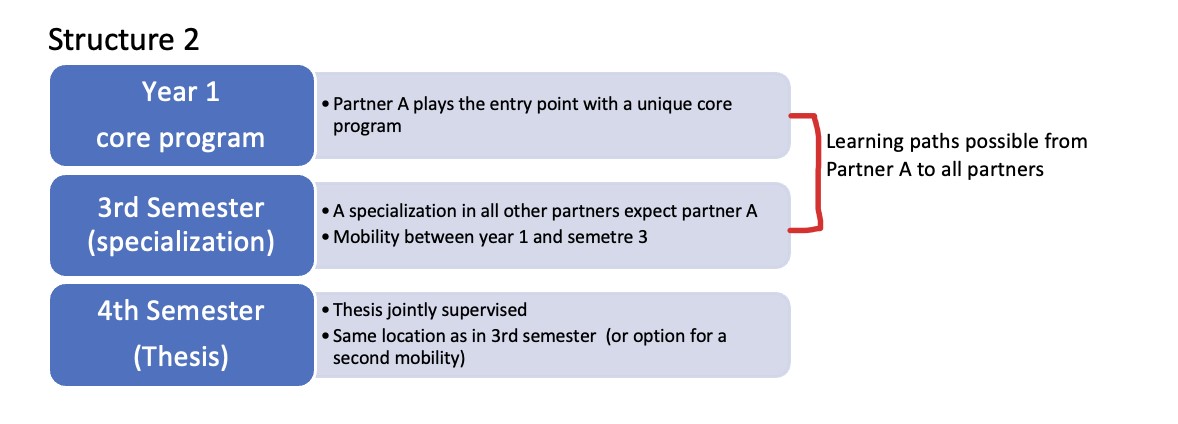Tips and recommendations for JP curriculum design
- Before starting, choose the partners with whom you will be building the consortium of the JP. The choice of partners could be related to many criteria including strategic partnership development plans of your university. Regarding the curriculum design aspects however, two criteria are useful: similarities between existing programs and the complementarities among the partners. The former facilitates the identification of a cohesive set of core courses that form the foundation of the program, while the latter aids in the development of original programs that would not be possible without the collaboration of the consortium.
- Define the study field (or subject area) with the consortium partners of the JP. All partners should have a common understanding of the learning outcomes and essential elements of this subject area.
- It is rare that a JP is built from scratch due to limited university resources and area of expertise of academic staff. Usually, they rely (partially or totally) on existing degree programs at each partner. Each partner defines the course program(s) that is the most suitable as a basis for the subject area of the JP in its program catalogue.
- Perform a needs analysis on the study field of the JP as early as possible. Collect stakeholders’ point of view on what the expectations are from a JP in this study field. This is useful for two reasons in curriculum design: to identify what is missing in the current programs in each partner (and at least at European level, and at the best worldwide) and to build the originality of the curriculum upon identified but unfulfilled needs in the field. Note that the needs analysis is required if you apply for funding (Erasmus Mundus, for instance) and will also be useful at the commercialisation phase of your JP.
- Program goals and objectives: Based on the common understanding of the subject area and the needs analysis, define the overarching goals, target competencies and skills and specific learning objectives that students are expected to achieve by the end of the program.
Courses
- Defining course content: concerns selecting and organising the contents of individual courses to ensure they contribute to the overall objectives of the program.
- Design a field study (subject area) model that lists the themes and domains that the JP shall cover to achieve the target competencies and skills.
- Each partner identifies the courses from the local course offerings that can contribute to identified themes and domains. This can be done by mapping the course catalogue onto the subject area model by each partner. The contents and nature of the course (mandatory or optional) as well as prerequisites shall be recorded for each course.
- From this map, we can deduce courses that are similar in all (or a subset of partners), the specialties and competencies of each partner, as well as constraints to take into consideration (mandatory courses and prerequisites)From this map, we can deduce courses that are similar in all (or a subset of partners), the specialties and competencies of each partner, as well as constraints to take into consideration (mandatory courses and prerequisites). These observations will be useful when deciding the global structure and organising of the JP.
- Determine whether there are any absent courses that may pose a risk to the achievement of the program's overarching learning objectives. Such courses might present opportunities to design joint courses among partners. If there are too many of them on a specific theme, integrating a new partner into the consortium with these competencies can be discussed.
- Besides courses, it is very important to identify the professors who can contribute to the JP and integrate them in the curriculum design process as early as possible.
- While selecting the courses to be included to the program you may also consider the following:
-
- Joint courses and activities are expected in JPs. Depending on the JP structure, the need might be different. For instance, if Structure 1(below) is selected, joint courses and activities will be beneficial to foster a sense of belonging to a community among students who, despite being distributed among multiple partners, will feel connected to the same program.
- Joint activities can comprise joint courses (with virtual and/or blended mobility), joint projects, summer or winter schools, professor mobility, etc.
- Seek for opportunities of mutualisation of courses, teaching materials, and technological platforms
- Besides technical courses, think about integrating soft skills, M&Ms, and entrepreneurship.
● Some challenges remain, such as:
-
- Incompatibilities in teaching calendars among partners.
- Differences between ECTS credits for teaching units.
- Set of mandatory courses to ensure at each partner.
Programme structure
Choose the program structure and describe the mobility paths. Imagine mobility paths so that students benefit from the excellence and complementary competencies of each partner, with a self-customised program. Common JP structures and mobility paths are presented in the next section below. Each has its own advantages and disadvantages and may not be applicable for all JPs. The following shall be considered (among others) in the choice of program structure and the potential learning paths:
- Core courses of the degree program: If all courses of a core program are not available at all partners, Structure 1 (picture below) is not applicable.
- Mandatory courses and prerequisites: mandatory courses and prerequisites constrains the potential learning paths. All learning paths may not be possible.
- Complementarities and expert domain of each partner may help in defining which subset of partners will be the entry institutions and which ones will be the exit institutions.
- Enrollment capacity: The number of students expected in the program may also impact the choice of the program structure depending on how the student flow is expected to be shared in the consortium.
● Sequencing and Progression concerns planning the sequence of courses in each semester to ensure a logical and progressive development of knowledge and skills. This includes considering prerequisites and the gradual complexity of the material, as well as the specialisations decided previously.
● Assessment methods shall be discussed. This may include exams, projects, presentations, and other forms of evaluation. This step is especially important to consider for the joint courses and for the assessment of the joint thesis.
● Integration of research activities through master’s thesis is mandatory at master's level JPs. Since this activity is in general a joint activity among consortium partners several issues shall be clarified: choice and validation of the thesis subject, supervision and expected deliverables during the thesis, requirements on the thesis report and the thesis defence, including the definition of the assessment rules.
● Integration of applied learning: Besides master’s thesis incorporating opportunities for internships, or other applied learning experiences, that align with the goals of the master's program. See chapter on Internships for further information.
● Think about flexibility and adaptability of the program at the design phase in order to accommodate different learning styles, backgrounds, and potential changes in the field. For instance, it is easier to adopt programs when there are many optional courses (than only mandatory courses).
● Feedback and evaluation: Establishing mechanisms for collecting feedback from students and instructors and using this feedback to continuously improve the curriculum.
Common programme structures and embedded mobility
Remarks structure 4: This structure might be useful when some of the partners have shorter degree programs (Master programs with 90 ECTS for some partners). Structure 5: Each mobility is to a different partner. A student may come back to the entry point after his/her 3rd mobility. This structure is rather rare since it requires a lot of flexibility and may be difficult to put in place unless a joint diploma is delivered by all partners.




